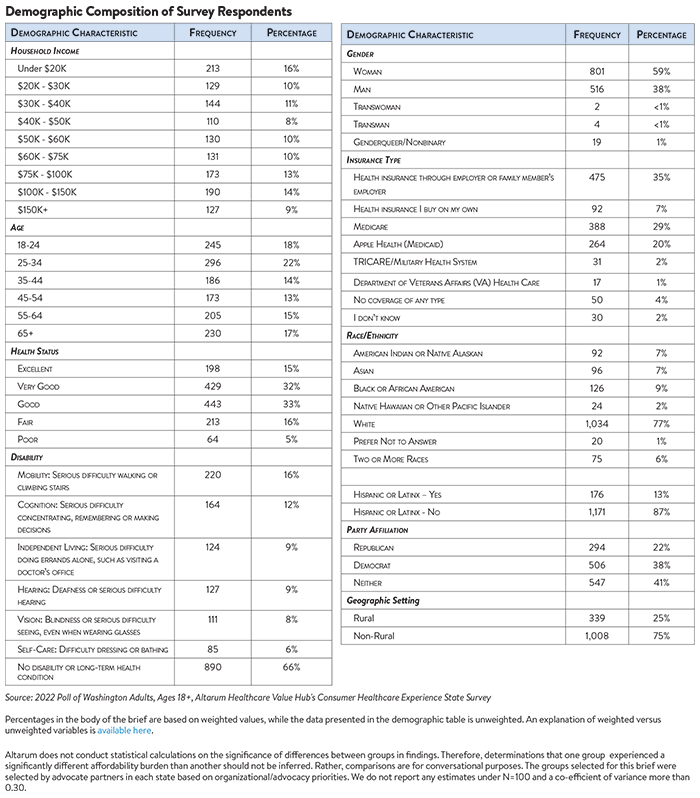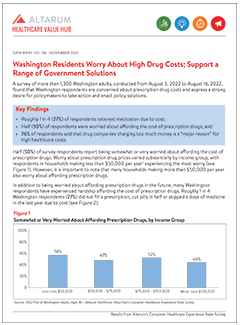Washington Residents Worry About High Drug Costs; Support a Range of Government Solutions
A survey of more than 1,300 Washington adults, conducted from August 3, 2022 to August 16, 2022, found that Washington respondents are concerned about prescription drug costs and express a strong desire for policymakers to take action and enact policy solutions.
Key Findings
- Roughly 1 in 4 (27%) of respondents rationed medication due to cost;
- Half (50%) of respondents were worried about affording the cost of prescription drugs; and
- 76% of respondents said that drug companies charging too much money is a “major reason” for high healthcare costs.
Half (50%) of survey respondents report being somewhat or very worried about affording the cost of prescription drugs. Worry about prescription drug prices varied substantially by income group, with respondents in households making less than $50,000 per year1 experiencing the most worry (see Figure 1). However, it is important to note that many households making more than $50,000 per year also worry about affording prescription drugs.
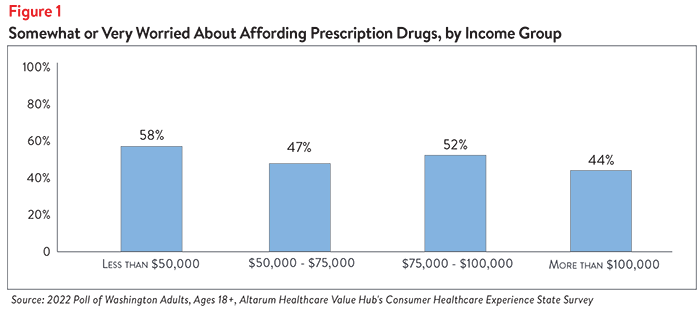
In addition to being worried about affording prescription drugs in the future, many Washington respondents have experienced hardship affording the cost of prescription drugs. Roughly 1 in 4 Washington respondents (27%) did not fill a prescription, cut pills in half or skipped a dose of medicine in the last year due to cost (see Figure 2).
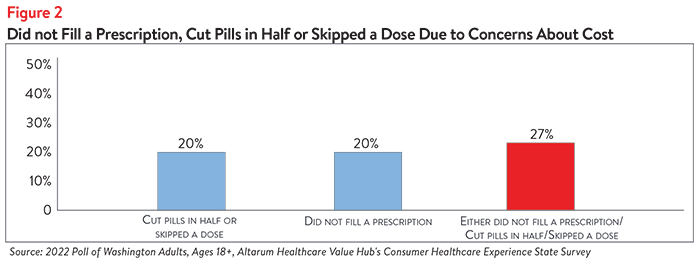
Different populations experienced greater prescription drug affordability challenges, shown in Table 1. Respondents living in households with a person with a disability reported notably higher rates of rationing medication due to cost (46%) in the past 12 months compared to respondents without a disabled household member (18%). Some people of color also reported higher prescription drug affordability challenges—Black/African American respondents (37%) and Hispanic/Latinx respondents (40%) reported higher rates of rationing their prescription medicines than other groups. Comparing across insurance types, respondents enrolled in Apple Health (Washington State’s Medicaid plan for people with low incomes) reported the highest rates of rationing medication (37%) compared to other insurance types, but respondents with private health insurance also reported rationing medication as well (28%). By geographic area, respondents living in rural areas reported higher rates of rationing medication (37%) compared to those in non-rural areas (24%).
Finally, respondents living in households earning less than $50,000 and those earning between $75,000 and $100,000 per year reported the highest rates of not filling a prescription, cutting pills in half or skipping a dose of medicine compared to respondents living in households earning greater than $100,000 a year (see Table 1). However, these hardships are alarmingly prevalent in all income levels.
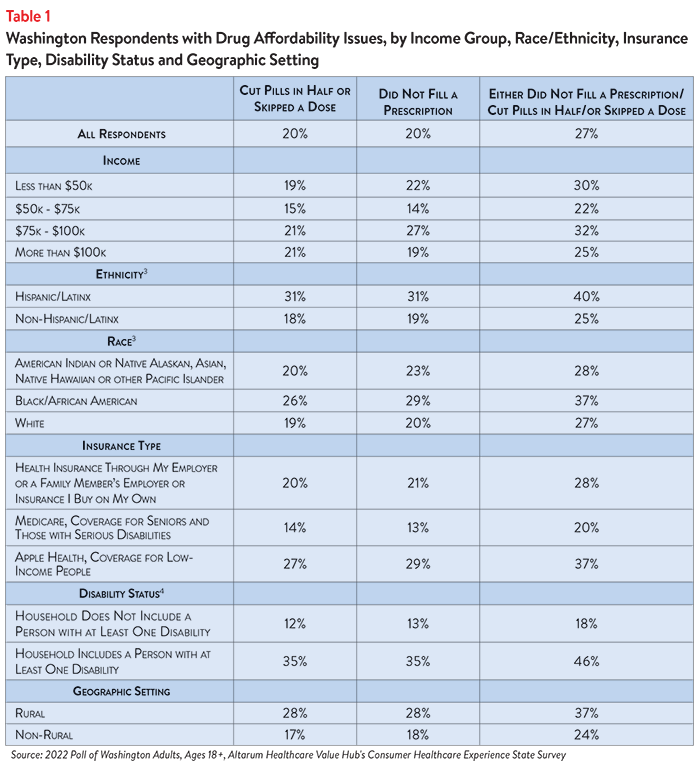
In light of these prescription drug cost concerns—as well as concerns about high healthcare costs generally2—it is not surprising that Washington respondents expressed dissatisfaction with the health system and recognized the need for improvement:
- Just 33% agreed or strongly agreed that “we have a great healthcare system in the U.S.,”
- While 73% agreed or strongly agreed that “the system needs to change.”
When given more than 20 options, respondents most frequently said that the “major reasons” for high healthcare costs were:
- 76%—Drug companies charging too much money
- 68%—Hospitals charging too much money
- 68%—Insurance companies charging too much money
When it comes to tackling high drug costs, Washington respondents endorsed several prescription drug-related strategies for policymakers:
- 92%—Cap out-of-pocket costs for life-saving medications, such as insulin
- 91%—Require drug companies to provide advanced notice of price increases and information to justify those increases
- 91%—Set standard prices for drugs to make them affordable
- 89%—Authorize the Attorney General to take legal action to prevent price gouging or unfair prescription drug price hikes
- 89%—Prohibit drug companies from charging more in the U.S. than abroad
Moreover, there is substantial support for government action on drug costs regardless of the respondents’ political affiliation (see Table 2).
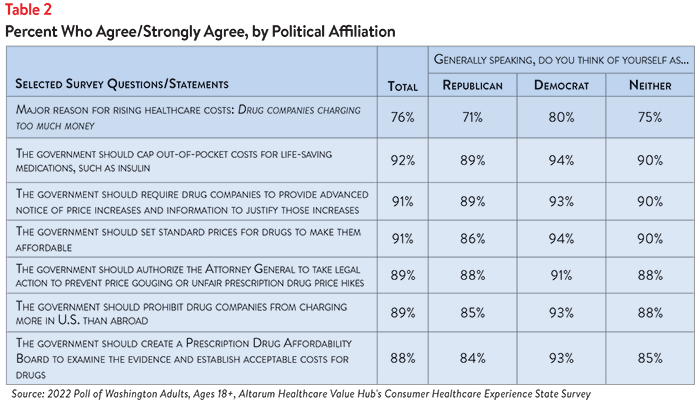
While Washington respondents across the political spectrum support the government taking action to address high drug costs, they also see a role for themselves:
- 72% would switch from a brand name to an equivalent generic drug if given a chance
- 51% have tried to find out the cost of a drug ahead of time
Conclusion
The high burden of healthcare and prescription drug affordability, along with high levels of support for change, suggest that elected leaders and other stakeholders need to make addressing this consumer burden a top priority. Moreover, the COVID crisis has led state residents to take a hard look at how well health and public health systems are working for them, with strong support for a wide variety of policy actions. Annual surveys can help assess whether progress is being made.
Notes
1. Median household income in Washington was $77,006 (2016-2020). U.S. Census, Quick Facts. Retrieved from: U.S. Census Bureau QuickFacts: Washington
2. For more detailed information about healthcare affordability burdens facing Washington respondents, please see Healthcare Value Hub, Washington Residents Struggle to Afford High Healthcare Costs; Worry About Affording Healthcare in the Future; Support Government Action Across Party Lines.
3. Regarding race/ethnicity categories, the survey separates Black/African American, Hispanic/Latinx and White respondents because there were at least 100 responses for each group. Rather than grouping and labeling the remaining respondents who were American Indian or Native Alaskan, Asian and Native Hawaiian or other Pacific Islander into an “Other” category, this brief instead listed them out together in a single remaining category.
4. Regarding disability status, respondents were asked if they or someone in their household identifies as having a disability or long-term health condition related to mobility, cognition, independent living, hearing, vision and self-care.
Methodology
Altarum’s Consumer Healthcare Experience State Survey (CHESS) is designed to elicit respondents’ unbiased views on a wide range of health system issues, including confidence using the health system, financial burden and views on fixes that might be needed.
This survey, conducted from August 3 to August 16, 2022, used a web panel from online survey company Dynata with a demographically balanced sample of approximately 1,502 respondents who live in Washington. Information about Dynata’s recruitment and compensation methods can be found here. The survey was conducted in English or Spanish and restricted to adults ages 18 and older. Respondents who finished the survey in less than half the median time were excluded from the final sample, leaving 1,347 cases for analysis. After those exclusions, the demographic composition of respondents was as follows, although not all demographic information has complete response rates:
